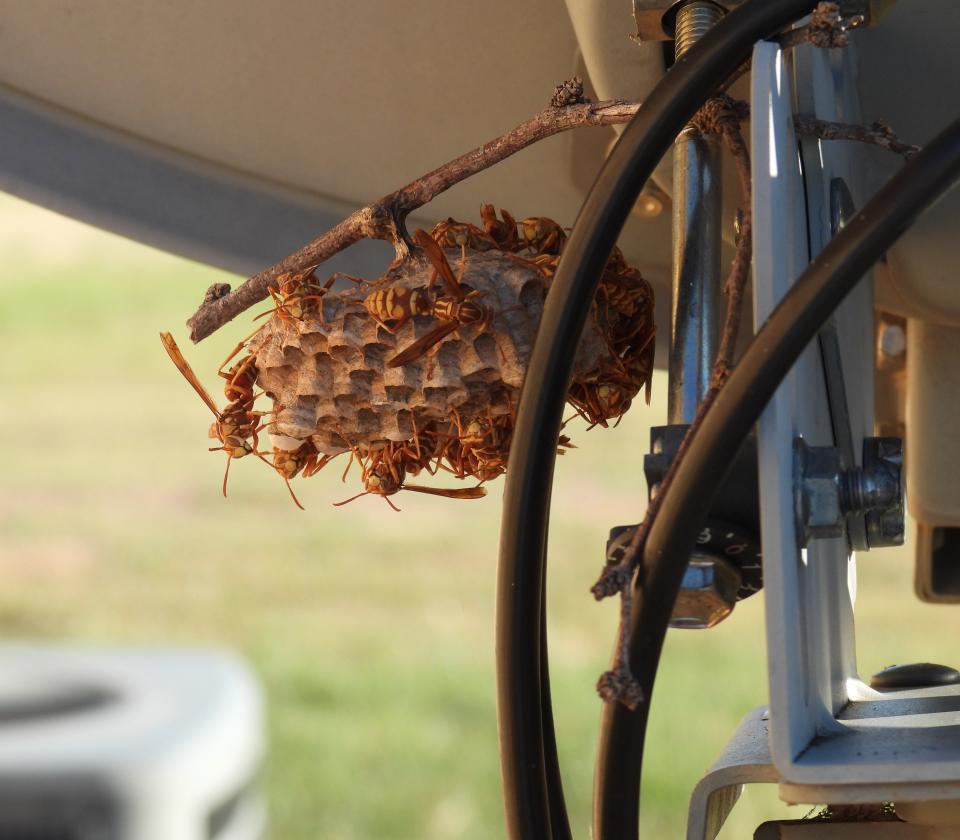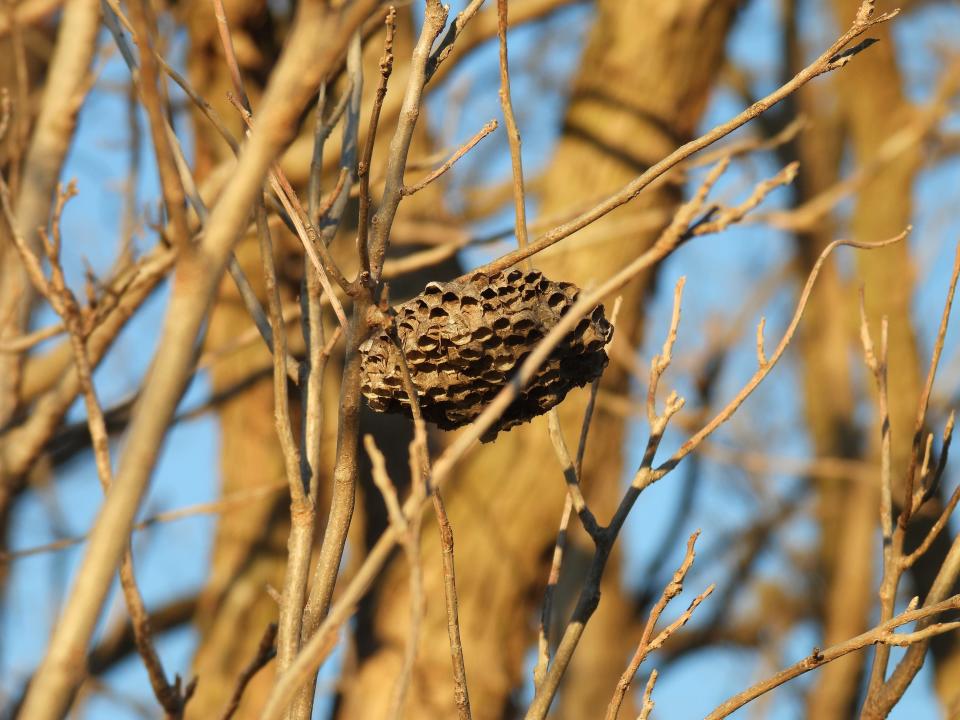Watch for these social wasps: Often feared but also helpful Insects
Wasps are often feared and respected for their ability to sting.
Some species may become aggressive if closely approached or disturbed. Others will not sting people or animals until after direct contact or aggressive interactions with humans and/or animals.
Exterminators are often called when nests or wasps are discovered at residences or businesses. However, if wasps can be tolerated, they provide some biological control of pests and pollination services to gardens and crops.

Over 4,000 species of wasps occur in North America. Wasps belong to a large group of insects which includes ants, bees and related insects.
Social vs. solitary
Some wasp species live in genetically related groups and are said to be social while other wasps are solitary. Types of nests vary between wasps. Some wasps build large, roughly cone-shaped nests of a paper-like material. Others build their nests from mud.
Still other wasp species burrow into the ground to construct their egg chambers, and some wasps construct no nests but, instead, deposit an egg or eggs directly inside the bodies of specific prey/host species.
Many adult wasps are nectivores, but queen wasps and/or worker wasps fastidiously provision nests and egg chambers with varying food items to be consumed by the larval stages of their young.
Different wasp species may live in close proximity without much apparent competition as they aerially search for appropriate food and prey items although some wasps are wingless and forage on the ground and upon vegetation.
Yellow jackets and paper wasps
With this information in mind, let us discuss the life history strategies of two types of social wasps.
Paper wasps and yellow jackets are found throughout our region. I more often encounter paper wasps around my residence, buildings, equipment and pasture lands than yellowjackets.
Yellowjackets tend to have wider abdomens and a overall broader body than the slimmer paper wasps. Yellow jackets have a yellow and black striped pattern. But some paper wasps are tan-colored with black, red and yellow markings on the abdomen and tan wings.
An additional paper wasp common in our area is the red paper wasp which, as its name implies, is an overall reddish-brown color with dark, black wings.
Wasps and their paper-mache nests
Yellow jackets and paper wasps construct nests by chewing and sticking wood and other vegetative material together into a paper-mache building material.
The nests of paper wasps are usually attached to tree branches, building eaves, rafters, walls and other structures by a narrow stalk that widens into an inverted cone containing honeycomb-like chambers. The nests of yellow jackets also contain honeycomb shaped chambers.

But yellow jacket nests are enclosed and protected by wrapped outer layers of paper-mache. Yellow jacket nests have a single opening which serves as both entrance and exit. Yellow jackets usually construct their nests in ground burrows, within hollow logs and trees, and/or within the internal spaces of building walls.
Social strategies, queens and pest control
Nest construction is initiated in the spring by overwintering queen wasps (referred to as foundresses). Yellow jacket queens are larger than their female worker wasp offspring, and yellow jacket queens have a distinctive, orange-colored abdomen as opposed to the yellow and black abdomen of workers.
Paper wasp queens are often indistinguishable from their colonies’ worker females. After constructing the initial nest, queens lay the first eggs and feed their developing larvae a diet of nectar and captured and partially masticated/chewed arthropods.
After the first workers pupate and emerge as mature wasps, the queens usually remain on or in the nest to lay more eggs while the workers enlarge the nest and forage for food to sustain the developing larvae and growing colony.
Reproductive males and females are produced in summer and fall, and young queens disperse to begin new colonies and/or overwinter until the following spring.
Paper wasps and yellow jackets forage during daylight hours, and all colony members return to their nests overnight. Prey items include caterpillars, flies, crickets, snails and beetle grubs.
Both types of wasps also forage through garbage and human refuse for appropriate scraps of meat, fruit and vegetable matter for themselves and/or their larvae.
Drunken wasps
Wasps sometimes become nuisances around hummingbird feeders, flowerbeds and gardens as they are attracted to the sugary water and flower nectar. I’ve noticed several reports of wasps becoming intoxicated/drunk and more aggressive after consuming fermenting fruits.
However, (provided that I haven’t just been exceptionally lucky), I have planted cow peas, purple hull peas and other pea varieties in my vegetable garden for several seasons and have encountered many intoxicated paper wasps sipping nectar from the flowers of my pea plants.
In my personal experience over these years, I’ve only had to gently nudge aside the tipsy wasps (not swatting at them) and have successfully gathered all my peas without suffering a single wasp sting.
The inebriated wasps staggered a bit on the leaves and/or stems but ignored me and quickly returned to the flowers for more nectar!
What preys on wasps?
Natural predators of wasps include some insectivorous birds, such as swallows and flycatchers; other insects, such as praying mantids and dragonflies; and a few types of centipedes and spiders.
Skunks and raccoons also raid yellow jacket and paper wasp nests and consume the wasp’s larvae. Many types of insecticide sprays, repellants and insect traps are effective against wasps, and peppermint and citronella oils are natural deterrents.
Avoiding the sting
Yellow jackets and paper wasps help reduce numbers of some invertebrate pests in our neighborhoods, but these wasps are territorial and will defend themselves and their nests by stinging (sometimes in swarms).
Therefore, it’s always best to be on the lookout for the nests and presence of yellow jackets and paper wasps during spring, summer and fall months.
Jim Goetze is a retired professor of biology and former chairperson of the Natural Sciences Department of Laredo College with an avid interest in all aspects of the natural world. He can be contacted at gonorthtxnature@gmail.com.
This article originally appeared on Wichita Falls Times Record News: Watch for these social wasps: Often feared but also helpful Insects

